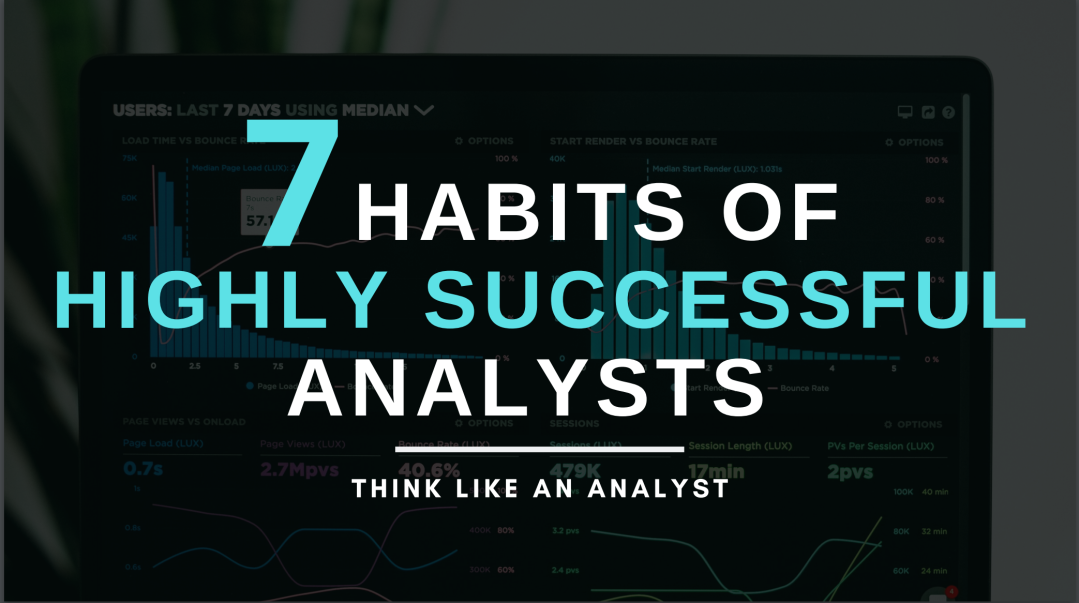THINK LIKE AN ANALYST
As a new analyst, there are things you can pick up on fairly quickly. However, being a highly successful analyst takes more than the fundamentals.
At work, you are surrounded by experienced professionals. Take advantage of that and observe how senior analysts work and present their findings.
What makes a highly successful analyst, isn’t the amount of work you do or data you process (though it’s part of it). Rather, it’s how you go about your analysis.
While working on my biggest deal yet, one of my mentors at work said to me, “Rainee, think like an analyst. Always do. It’s a mindset.”
But, what does this mean? How do analysts think? So, I started thinking… about how to think like an analyst. After contemplation, practice, and observance, I have narrowed down some habits and approaches of highly successful analysts.
Highly successful analysts always:
1. Look at the Bigger Picture
Analysts don’t only focus on the smaller analytics, rather how the analysis can add value in the grand scheme. They ask themselves what they are looking for, what data is relevant in drawing conclusions and creating forecasts. By understanding the purpose of the analysis, they are able to bring forth relevant insights. This way, the analysis produced is aligned with its objectives.
2. Visualize Data
They present numbers in a visually appealing and easily comprehendible manner. Their coworkers are able to just glance at their presentation and understand the trends camouflaged within numbers. Diagrams, graphs help visualize those numbers. Great analysts never hesitate to put the data in a graph.
To Piggyback that, great analysts make superior graphs. They use complementing colours, moving averages, data labels, and idoneous graph types.
With time, will get better at determining the best way to present your findings, but you can start today by stepping up your presentation game.
3. Present Takeaways
A highly successful analyst does not stop at the facts. Their final product does not only contain basic insights, but it also consists of key takeaways.
For example, data reveals that hotel occupancy rates and revenue per available room (RevPAR) are declining.
So, what does this mean? When will they go back up? What are the previous trends?
Professional analysts always back up facts with reasoning and present a takeaway. A takeaway derived from research, accompanying your graphs, should look something like this:
| As COVID-19 continues to strain the economy, hotel occupancy rates are forecasted to drop to 25% by mid-2020. Similarly, a colossal drop was witnessed during the 2008-2009 economic downturn, where hotel occupancy rates dropped to 54% from 60% in the United States.1 During this period, RevPAR dropped to $54 in 2009 from $64 in 2008; it took the hotel market 3 years to increase RevPAR to the $64 mark.2 RevPAR in 2020 is forecasted to drop to $42 from $84 in the U.S., but increase to 52 by end of 2021.3 Considering the severity of the current situation, hotel occupancy rates may normalize by mid-2021, although hotels will struggle to bring RevPAR to back up to its pre-COVID value. 1 Source: Oxford Economics & ALHA Study 2 Source: PWC Hospitality Directions data as of 2017 – Hotel News Now 3 Source: STR Tourism Economics |
4. Make Recommendations
Apart from takeaways, highly successful analysts make recommendations for decision-making. From their conclusions, they derive a course of action for the company to take. If negative insights are revealed, they recommend risk mitigation tactics and solutions. Otherwise, they leverage positive insights to create new opportunities. As such, they are able to deliver on their analysis and take it to the next level by making appropriate suggestions.
5. Leverage Trends and News
Keeping up the trends and news is fundamental, though leveraging them to add value to analysis is paramount. The highly successful analysts always stay in the know.
Know and understand: What’s happening in the market? What’s happening around the world? How can I use these to draw conclusions from my analysis?
They use this information to justify their analysis, narrating the findings.
6. Have a Winning Formula
Highly successful analysts establish an analytical routine or a formula on how to go about their work. For the best analysts, their work is intuitive; they are able to execute with speed and a high degree of effectiveness. This stems from a winning formula they have created for themselves, personalized to their working patterns.
It’s important to draft a routine for yourself so you can know where to look and exactly what you need to look for. Once you craft your basic analysis recipe, you will be able to work efficiently and effectively.
7. Foster Curiosity
Analysts are always curious and question everything. Curiosity acts as a driving force to find answers and insights. They uncover any gaps in their analysis, never hide them. When they come across a situation that needs more clarity, they look further to find more information and resolve any concerns.
And with that, we have reached the end of this post. I hope you are encouraged to cultivate advanced analytical skills. As I mentioned earlier, with experience and practicing smart habits, you will become a highly successful analyst.
What other habits do highly successful analysts have? Comment down below and let me know. Don’t hesitate to find me on Instagram @_reallifewithrainee. Be sure to share if you enjoyed this post. Subscribe for more.

